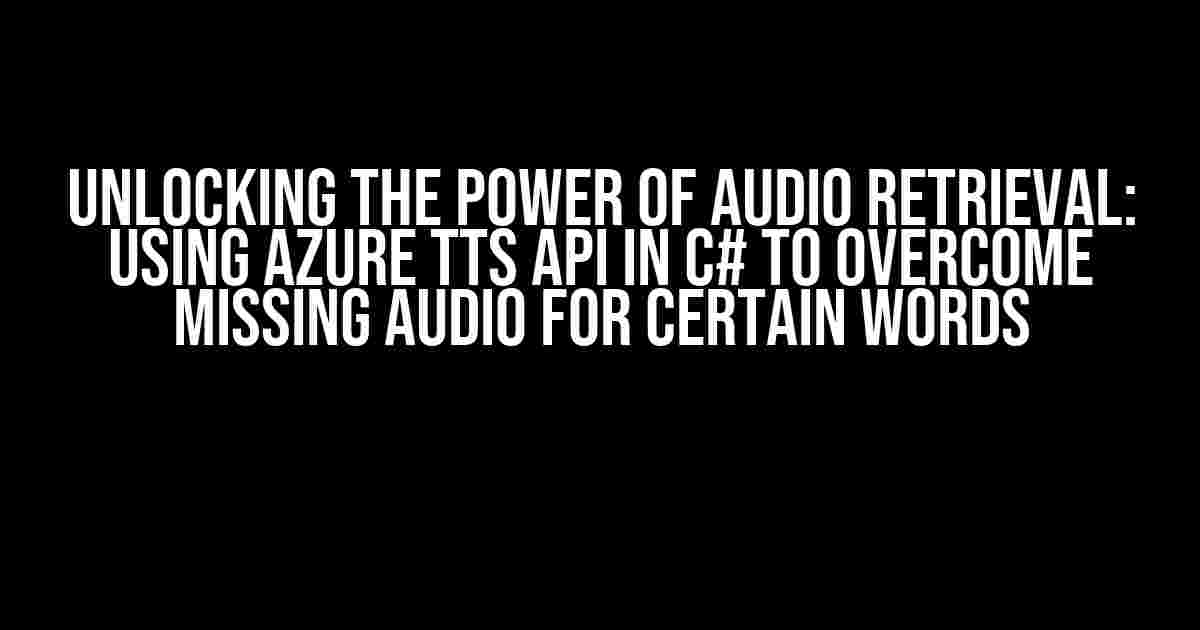Imagine being able to generate high-quality audio files from text input, effortlessly and efficiently. With the Azure Text-to-Speech (TTS) API, you can do just that – but what happens when you encounter missing audio for certain words? In this article, we’ll dive into the world of audio retrieval using Azure TTS API in C# and explore solutions to overcome this common challenge.
What is Azure TTS API?
The Azure TTS API is a cloud-based service that converts written text into natural-sounding speech, allowing developers to integrate high-quality text-to-speech capabilities into their applications. With support for over 100 voices and 30 languages, the Azure TTS API is an ideal solution for a wide range of use cases, from chatbots and virtual assistants to audiobooks and language learning tools.
Benefits of Using Azure TTS API
- High-quality audio output: Azure TTS API uses advanced machine learning algorithms to generate natural-sounding speech that rivals human quality.
- Customizable voices and languages: Choose from a vast range of voices and languages to tailor the audio output to your specific needs.
- Scalability and reliability: Azure TTS API is built on a robust cloud infrastructure, ensuring seamless performance and reliability even under high loads.
- Cost-effective: Azure TTS API offers a pay-as-you-go pricing model, making it an affordable solution for businesses of all sizes.
Audio Retrieval Using Azure TTS API in C#
To get started with audio retrieval using Azure TTS API in C#, you’ll need to:
- Create an Azure account and subscribe to the Azure TTS API.
- Install the Azure Cognitive Services Speech SDK NuGet package in your C# project.
- Obtain an API key and region information for the Azure TTS API.
using System;
using System.IO;
using Microsoft.Azure.CognitiveServices.Speech;
namespace AzureTTSAPI
{
class Program
{
static void Main(string[] args)
{
// Set API key and region
string apiKey = "YOUR_API_KEY";
string region = "YOUR_REGION";
// Create a new speech config
var config = new SpeechConfig(apiKey, region);
// Create a new speech synthesizer
var synthesizer = new SpeechSynthesizer(config);
// Set the text to synthesize
string text = "Hello, world!";
// Synthesize the text to audio
using (var result = synthesizer.SpeakAsync(text).Result)
{
// Check the result status
if (result.Reason == ResultReason.SynthesizingAudioCompleted)
{
// Write the audio to a file
using (var fileStream = new FileStream("output.wav", FileMode.Create, FileAccess.Write))
{
result.Audio.CopyTo(fileStream);
}
Console.WriteLine("Audio file generated successfully!");
}
else
{
Console.WriteLine("Error synthesizing audio: " + result.Reason);
}
}
}
}
}
The Challenge: Missing Audio for Certain Words
While the Azure TTS API is incredibly powerful, you may encounter an issue where certain words or phrases are missing from the generated audio. This can occur due to a variety of reasons, including:
- Lack of pronunciation data for specific words or phrases.
- Insufficient context or surrounding text to accurately pronounce the word.
- Limitations in the TTS engine’s language model or acoustic model.
Solutions to Overcome Missing Audio
Fear not, dear developer! There are several strategies to overcome the challenge of missing audio for certain words:
1. Use a Different Voice or Language
Try switching to a different voice or language to see if the audio output improves. You can do this by modifying the `SpeechConfig` object to use a different voice or language:
var config = new SpeechConfig(apiKey, region)
{
Voice = new SpeechSynthesisVoice
{
VoiceName = "en-US-JennyNeural"
}
};
2. Pre PROCESS the Input Text
Pre-processing the input text can help improve the accuracy of the audio output. This can involve:
- Tokenizing the text to break it down into individual words or subwords.
- Applying phonetic transcription to.convert words into their phonetic equivalents.
- Using a spell checker or grammar corrector to ensure the input text is accurate.
3. Use a Custom Dictionary or Lexicon
Creating a custom dictionary or lexicon can help the TTS engine better understand the pronunciation of specific words or phrases. This can be done by:
- Defining a custom pronunciation for specific words or phrases.
- Creating a dictionary of commonly used terms or industry-specific jargon.
4. Use a Third-Party Dictionary or API
Integrating a third-party dictionary or API can provide additional pronunciation data or language models to improve the accuracy of the audio output. Some popular options include:
- Merriam-Webster’s API for accessing pronunciation data.
- CMU Pronouncing Dictionary for phonetic transcriptions.
Conclusion
In this article, we explored the world of audio retrieval using Azure TTS API in C# and delved into the challenge of missing audio for certain words. By understanding the benefits of using Azure TTS API and implementing the strategies outlined above, you can overcome this common challenge and generate high-quality audio files that meet your specific needs.
| Strategy | Description |
|---|---|
| Use a Different Voice or Language | Try switching to a different voice or language to see if the audio output improves. |
| Pre-process the Input Text | Tokenize the text, apply phonetic transcription, or use a spell checker to ensure the input text is accurate. |
| Use a Custom Dictionary or Lexicon | Define a custom pronunciation for specific words or phrases, or create a dictionary of commonly used terms. |
| Use a Third-Party Dictionary or API | Integrate a third-party dictionary or API to provide additional pronunciation data or language models. |
By implementing these strategies, you can unlock the full potential of the Azure TTS API and generate high-quality audio files that meet your specific needs. Happy coding!
Frequently Asked Questions
Get answers to your questions about audio retrieval using Azure TTS API in C#, missing audio for certain words.
Why am I missing audio for certain words when using Azure TTS API in C#?
This might be due to the pronunciation of those words not being supported by the Azure TTS API. Try checking the API documentation to see if the words are listed as unsupported. You can also try using a different voice or language to see if the issue persists.
How can I troubleshoot the missing audio issue in Azure TTS API?
First, check the Azure TTS API error logs to see if there are any error messages related to the missing audio. Then, try playing the audio files individually to see if the issue is specific to certain words or if it’s a general issue. You can also try using a different audio output format to see if that resolves the issue.
Can I use a different voice or language to retrieve the missing audio?
Yes, you can try using a different voice or language to retrieve the missing audio. Azure TTS API supports a range of voices and languages, so you can experiment with different options to see if that resolves the issue. Keep in mind that the available voices and languages may vary depending on your Azure subscription and region.
How can I pre-process the text to handle unsupported words in Azure TTS API?
You can pre-process the text by using a dictionary or thesaurus to replace unsupported words with synonyms or alternatives that are supported by the Azure TTS API. You can also use regular expressions to remove or replace unwanted characters or words from the input text.
Are there any workarounds for handling missing audio in Azure TTS API?
Yes, you can use a fallback audio or a default sound to fill in the gaps where audio is missing. You can also consider using a third-party text-to-speech API or service that supports a wider range of words and languages. Additionally, you can use a caching mechanism to store the generated audio files and serve them from cache instead of re-generating them every time.



